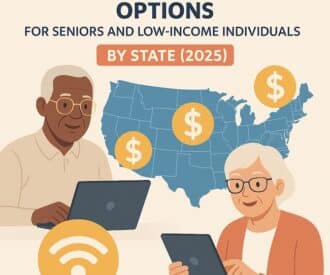Getting around town shouldn’t be a challenge as we age, yet transportation barriers can lead to isolation and missed medical appointments for many seniors. Traditional ridesharing apps may feel overwhelming, but specialized services now offer senior-friendly features like door-to-door assistance, trained drivers, and wheelchair accessibility.
In this article, we’ve curated eight reliable ridesharing options tailored to older adults’ needs—whether they prefer discounted fares, extra help getting in/out of vehicles, or non-tech booking methods. With these practical solutions, you can regain independence and stay connected to your community.

Safe and reliable transportation is essential for seniors to stay independent and healthy. People need rides to get to the doctor, see family and friends, and run errands. To help with this, many new companies have services that make finding transportation easier and more convenient for seniors. Caring.com shares eight ridesharing services that help seniors get rides anytime.
Transportation is rapidly changing, not least because of the proliferation of new ride-hailing services such as Uber and Lyft. In a short time, these convenient services have become crucial for getting around cities.
You might think these services have been a boon for seniors who cannot drive. But many seniors either don’t have a smartphone or aren’t comfortable using one. Others may need cars with handicap accessibility or help getting to and from the door.
Furthermore, ride-hailing services are only available in cities, leaving people who live in more rural areas without these options.
Luckily, various services have recently emerged to help seniors and their caregivers address some of these challenges, including recent initiatives by industry leaders Uber and Lyft.
Eight Great Ridesharing Services for Seniors
1. Uber
In 2015, ride-hailing behemoth Uber started a pilot program in Gainesville, Florida, to provide transportation for residents of two senior living communities.
The company offered technology tutorials to help seniors get comfortable using the app to request a ride. In 2016, Uber expanded the program to all seniors in Gainesville.
Though that program has yet to expand, Uber also offers some extra assistance for seniors with its Uber Assist program and has launched UberWAV in Toronto, giving riders a wheelchair-accessible option.
On the other hand, the company has been criticized at times for not offering more services for people with disabilities and has been sued under the Americans with Disabilities Act to provide more access.
Learn more at Uber.com.
2. Lyft
Like Uber, ridesharing giant Lyft is improving its outreach for seniors and access for people with disabilities. Last fall, Lyft announced a slate of solutions for obstacles to seniors using its services, including working with partners to take Lyft requests over the phone and making it easier for groups working with seniors to request rides on their behalf.
Lyft has also been working on making its service more accessible to people with disabilities. Like Uber, its coverage is spotty, and it has faced lawsuits over its ADA compliance.
Lyft has an app setting to request a vehicle capable of accommodating wheelchairs, but in areas where Lyft doesn’t have such vehicles, it recommends another service that may need to be booked 24 hours or more in advance.
Learn more at Lyft.com.
3. Go Go Grandparent
One service that’s popped up to help seniors manage Uber and Lyft is GoGo Grandparent, a call-in service that allows people who either don’t have or aren’t comfortable with smartphones to arrange rides.
The service offers an extra measure of assurance by employing “professional grandchildren” to ensure the ride goes smoothly. It features an option to alert the rider’s caregiver where their older loved one is going and who their driver is.
The service is largely automated, but operators are available if necessary.
The company was founded in Los Angeles last year by Justin Boogaard and David Lung. Boogaard says he started the service to help his grandmother and took all calls himself.
But his grandmother had an active social life; before long, he was taking calls for about 100 of her friends. It affected his sleep, and he realized he had to hire a staff.
GoGo Grandparent began charging for the service (19 cents per minute in addition to the standard Uber or Lyft fee) and has now accumulated tens of thousands of customers.
Learn more at GoGoGrandparent.com.
4. Arrive
Another smaller service similar to GoGo Grandparent is Arrive. Arrive is a members-only service that dispatches Lyft and Uber rides to customers, many of whom do not have smartphones.
Live operators provide an even higher level of service, giving drivers detailed descriptions of the riders before pickup.
“Most of what we're doing is directing the driver when they're at the address to find the rider,” says Arrive co-founder Amy Stice.
The company's hours of operation are limited to between 9 a.m. and 6 p.m. Pacific time, so most of its customers are still on the West Coast. But some East Coasters have been taking advantage of the service for evening activities like going to dinner, Stice says.
Stice, too, got the idea for the service when she was arranging Uber rides for her grandmother in Moraga, California. Now she’s providing the same service for between 100 and 200 others, half of whom don’t have cellphones.
“We're doing exactly what I used to do for my grandmother,” Stice said. “We're just asking for favors from the drivers to make it easier for the riders.”
Learn more at ArriveRides.com.
5. Liberty Mobility Now
In some of the country’s more rural areas, Liberty Mobility Now has emerged as a solution for basic transportation needs and a first- and last-mile solution for often spotty public transportation access.
“We've found that there's this intense demand for ridesharing and just improved transportation in rural areas,” says Tyler Bassinger, a spokesman for the company. “We go where people have expressed a high interest in this and then partner with a nonprofit or a government organization.”
Based in Lincoln, Nebraska, Liberty Mobility Now operates in seven states, employing its own fleet of drivers and partnering with whatever other transportation options are available to get people rides. The company’s goal isn’t to compete with Uber or Lyft but to fill in gaps, Bassinger said.
Liberty Mobility now covers areas of Ohio, South Dakota, Colorado, Virginia, and Missouri. It is working on operating statewide in Nebraska and is about to launch in Corpus Christi, Texas. While it provides rides for anyone, well over half of its clientele is seniors.
The company trains its drivers for ADA compliance and instructs them to go above and beyond with services like helping riders with their groceries.
Learn more at LibertyMobilityNow.com.
6. SilverRide
A company offering a comprehensive approach in the San Francisco area, SilverRide, was launched in 2007, well before Uber or Lyft. Its services are even more extensive, sometimes accompanying seniors on their outings if desired or necessary.
Before going anywhere, SilverRide drivers spend time with their clients and families to plan outings. According to the company’s website, they’ll take them on errands like doctor’s appointments and grocery shopping, as well as to ballgames, museums, restaurants, and parks.
When they pick up clients, the drivers go inside to help them to the car, and when they arrive at their destination, they also walk the client inside.
Learn more at SilverRide.com.
7. Via
Via – a carpooling service operating in New York, Chicago, and Washington, D.C. – has been very popular with seniors in New York City. According to an article in New York Magazine, seniors accounted for 27 percent of their riders late in 2015.
The service is simple: after booking a ride, a shared car picks up passengers at nearby street corners, and they ride together.
Uber and Lyft offer similar services that have received mixed reviews, but seniors in New York have raved about Via’s cheap prices and sense of community.
Learn more at RideWithVia.com.
8. National Volunteer Transportation Center
Volunteer Transportation Center is another organization helping to fill the gaps left by Uber and Lyft. Not a transportation provider itself, the center provides resources to roughly 800 volunteer driver programs nationwide.
The center’s database includes services ranging from small mom-and-pop operations to large, sophisticated programs. These services mainly cover rural areas that are difficult for Uber and Lyft to serve.
“They rise out of the interest in the community and the concern of the community,” said the center’s director, Helen Kerschner.
Volunteer drivers generally provide a much higher level of service than Uber or Lyft. They escort riders to the door and even stay and wait for hours while their rider goes for dialysis treatment or other lengthy appointments.
“They can take passengers to multiple destinations and stay with them at the destinations – these are important features that set them apart from other transportation services,” Kerschner says.
The center mainly exists to provide information about the services—a map of volunteer transportation services is available on its website—but it also assists in getting them funded by providing data analysis to help get government funding, giving annual cash awards, and potentially even a vehicle through a partnership with Toyota.
Learn more at the National Volunteer Transportation Center's website.
Recommended for you:
- 6 Affordable Senior Transportation Options
- 8 Ways to Stop an Elderly Person From Driving When All Else Fails
- 7 Warning Signs: How to Know When Your Parents Should Stop Driving
Guest contributor: Caring.com's mission is to help the helpers. We equip family caregivers to make better decisions, save time and money, and feel less alone and less stressed as they face the many challenges of caregiving.
This article contains affiliate links. If you buy through an affiliate link on our site, we may earn a small commission, at no additional cost to you. For more information, see How We Make Money.
About the Author
Caring.com
Caring.com's mission is to help the helpers. We equip family caregivers to make better decisions, save time and money, and feel less alone – and less stressed – as they face the many challenges of caregiving. Visit our site at www.caring.com to find helpful articles, support groups, and a comprehensive directory of local senior care resources.




